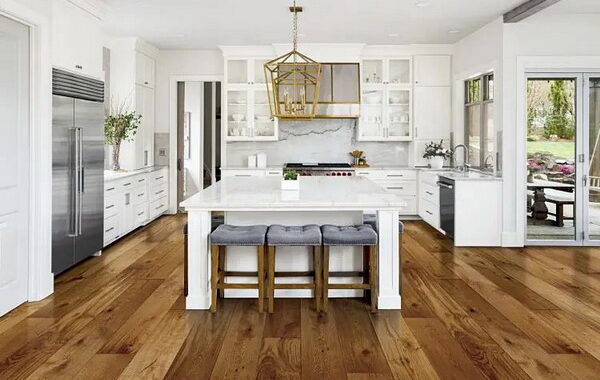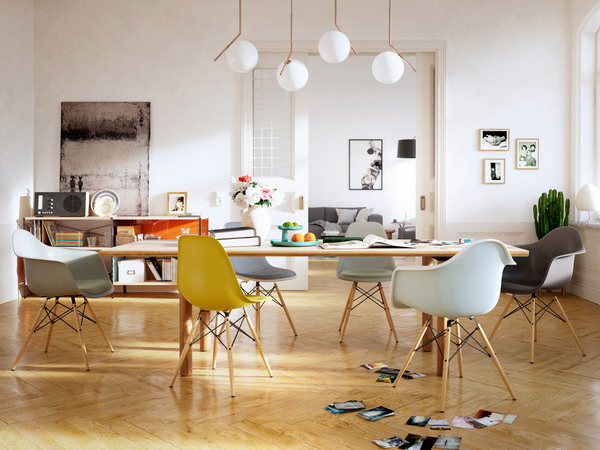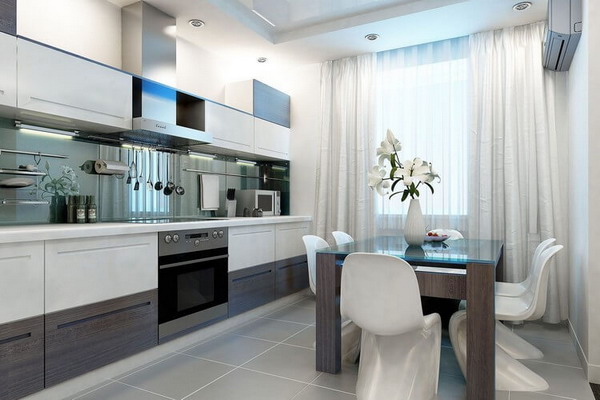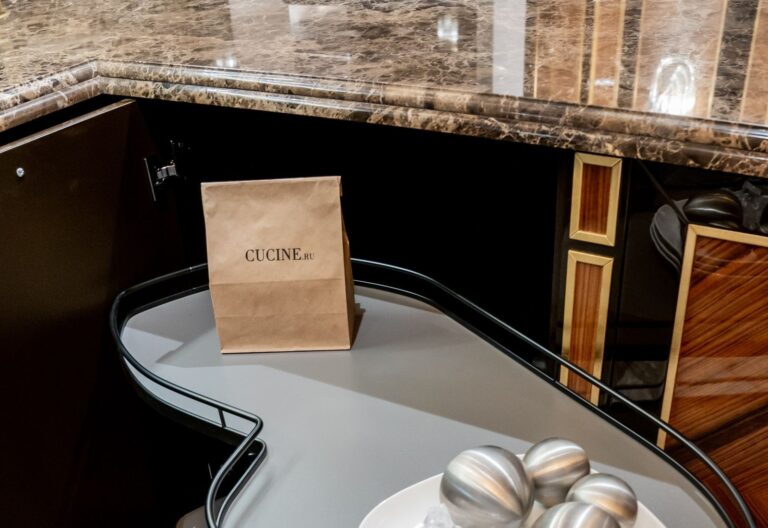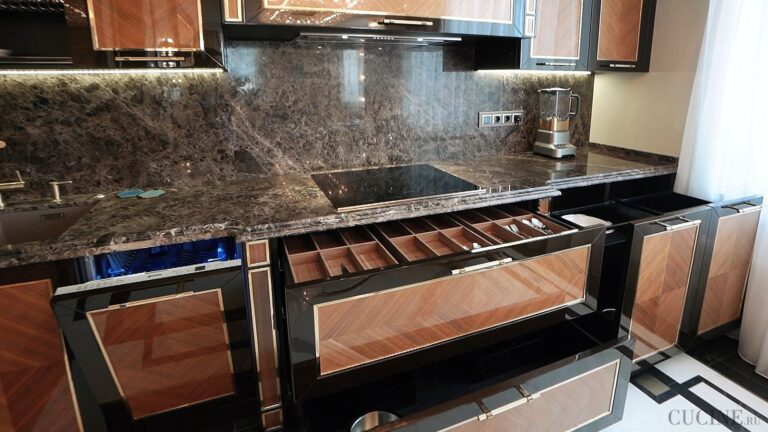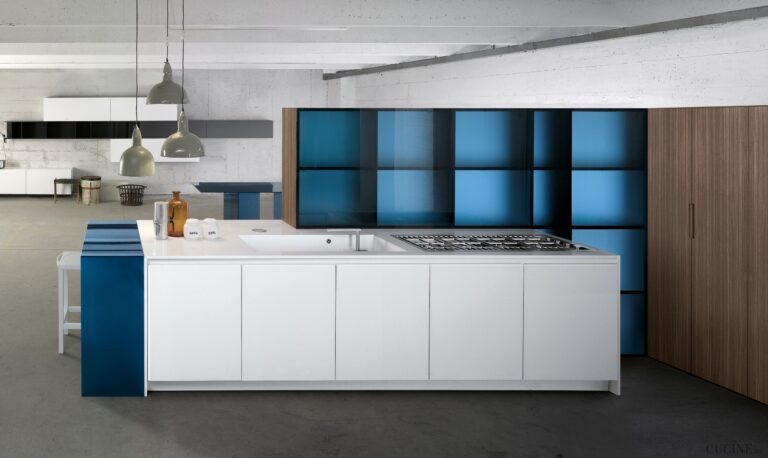Kitchen floor: These floors are best suited for the kitchen
Screed, tiled floor, vinyl floor or wooden floor? When it comes to kitchen flooring, there are almost no limits these days. While the foot-cold tiles still make it into the majority of kitchens as a cheap and practical all-rounder, designer floors made from natural materials such as parquet, cork or natural stone are also becoming increasingly popular. But are these floors really suitable for the kitchen, are they easy to care for or should they stay in the living area? In this blog article we will explain to you which criteria should be taken into account when choosing flooring in the kitchen and what advantages and disadvantages the different floor coverings have.
Contents
- Kitchen floor: What does the floor covering have to be able to do?
- Which material for the floor in the kitchen? The right covering
- Tiles – the classic among floorings
- Parquet flooring: the natural product as flooring in the kitchen
- Laminate – a cheap alternative to wooden flooring
- Kitchen floor: linoleum
- Cozy with the raw material of the cork oak: elastic cork
- Kitchen floor: vinyl with a tile or wood look
- Marble, granite & slate: Durable natural stone as a kitchen floor
- Kitchen floor: concrete
- Kitchen floor: carpet – do or don’t?
- Kitchen floor: What else needs to be taken into account?
Kitchen floor: What does the floor covering have to be able to do?
Chic but practical! Your own kitchen is often the focal point in your own four walls. That’s why the kitchen floor should, on the one hand, be visually appealing and fit well with the built-in kitchen. At the same time, however, it must also be robust and not be damaged by the slightest load. Even though much more than just cooking is done in the modern, partly open kitchen, meals are still being prepared and occasional stains shouldn’t harm the floor. When choosing the right floor for the kitchen, you should make sure that the floor is as durable as possible and does not require too much maintenance. Last but not least, the choice of floor covering is a question of taste and the available budget.
Resistance and longevity of the floor in the kitchen
People are working in the kitchen. Ideally, the floor should be able to remove falling dishes or leftover food, splashing water when washing up or moisture escaping from the dishwasher. Ultimately, you want to be able to use your new floor covering for as long as possible and not have to install a new kitchen floor again after just a few years because it has dents, scratches or even water damage. Therefore, it is important to choose flooring that can withstand everyday use. Do you use your kitchen often and do you ever drop something in the heat of the moment? If you don’t like tiptoeing around your kitchen and you want to allow and forgive yourself the odd mishap, you should choose flooring that suits your needs and lifestyle. Basically, you can base your flooring for the kitchen on the common usage classes for rooms. Since the use in the kitchen is very intensive, we recommend laying a floor with usage class 23.
Care and maintenance: Easy-care flooring for the kitchen
The floor in the kitchen also needs to be cleaned and maintained. Especially when you handle food, one or two crumbs end up on the kitchen floor. There is a spill or some splash water drips next to it. While coverings such as tiles or vinyl flooring are quite hard-wearing and do not require your immediate attention, the situation is completely different with wooden floors such as parquet. Stains should be removed as quickly as possible to avoid permanent discoloration or swelling of the floor. In addition to maintenance due to everyday mishaps, regular care should not be ignored. Some floor coverings need to be oiled or polished regularly to prevent them from becoming dull. Depending on the material you choose, some kitchen floors will inevitably require more work than others. If you want to have as little to do with maintenance as possible, it may be advisable to make compromises in the design and instead use a particularly easy-care covering.
Is the floor in the kitchen a design floor? Style and aesthetics
Your choice of flooring can change the entire look of your kitchen. That’s why you should ideally already know what your kitchen will look like when making your selection. Light or dark fronts? Matt or shiny? Modern or country house style? Depending on the style in which you want to furnish your kitchen, you can add additional aesthetics with the kitchen floor. Do you like it simple and modern? Parquet, marble or natural stone look very elegant and underline minimalist features. But playful interiors can also be perfectly combined with parquet or classic tiled floors. Since it’s not easy to replace a kitchen floor, you should choose a flooring that you find timeless, that you like and that fits the aesthetics of your kitchen.
Floor kitchen: costs
Last but not least, the choice of flooring in the kitchen is often a question of price. No matter how beautiful you may find natural stone and no matter how well marble fits the kitchen unit, not every kitchen floor can be realized for every budget. Always keep the price-performance ratio in mind. Although parquet is significantly more expensive to purchase initially than laminate, for example, it also has a longer service life.
Which material for the floor in the kitchen? The right covering
Floor coverings are a dime a dozen. Even if a lot can be sorted out by the criteria that a floor in the kitchen should meet, there are still various materials to choose from. Whether parquet, natural stone such as marble, cork floors or tiled floors – we give you detailed information about the different floors for the kitchen.
Tiles – the classic among floorings
Tiles are often the first choice for kitchen floors. Not only are they water-resistant and easy to clean, they also offer a wide variety of design options. Whether ceramic, porcelain or natural stone, tiles can be found in almost every style and color palette. Whether it’s a classic country house kitchen or a modern kitchen in the Japandi style – tiled flooring fits in every kitchen. In addition, tiles are very durable with a useful life of up to 30 years. They reliably withstand the everyday stresses in a busy kitchen. However, heavy objects should be avoided from falling, as the wear layer of the tiles may crack or break. Tiled flooring is also resistant to liquids. If the kitchen floor is laid properly and the joints are tight, tiles can also withstand stress such as moisture. The floor is also insensitive to dirt – stains can simply be wiped away with a damp or even wet cloth. However, if you are not a fan of thick socks or slippers in winter and do not have underfloor heating, you should consider whether tiles are actually an option as a floor in the kitchen. Tiles are hard and cold and cause cold feet in winter. When choosing tiles, also pay attention to the color of the joints. In principle, dark joints are spared from discoloration for longer and do not need to be repaired as quickly.
Parquet flooring: the natural product as flooring in the kitchen
The use of natural materials in kitchen design has been common practice for several years. Wood such as parquet is particularly popular. Natural raw materials such as wooden floors are also increasingly being used as kitchen floors. Not only does it give a kitchen warmth and character, but it also looks extremely modern when combined with the right kitchen front. In principle, parquet is considered a hard-wearing and long-lasting covering for the floor in the kitchen – however, it does not tolerate moisture or liquids such as water stains very well. Hardwood flooring is actually susceptible to moisture damage and can result in swelling. Therefore, parquet requires regular care and maintenance. It can also become scratched over time. If you want to keep your parquet floor long-term, you should choose parquet with a wear layer of at least 0.5 cm, as this can be sanded down repeatedly. Nevertheless, the natural elegance of parquet can help add a touch of luxury to your kitchen. Just be careful with the sink with this floor in the kitchen.
Laminate – a cheap alternative to wooden flooring
Are you a fan of the homely wood look, but parquet flooring is not easy enough to maintain or too expensive for you? Then laminate is an excellent choice for your kitchen floor. Laminate floors are not only cost-effective but also highly resistant to stains, scratches and abrasion. They are also available in a variety of designs and colors. This means you can replicate the look of more expensive materials such as wood or stone for your kitchen floor. However, it should be noted that laminate floors do not react well to moisture and can swell. In the event of water damage due to excessive moisture or spillage and penetration of a lot of liquid into the joints, the laminate must be replaced. Nevertheless, laminate floors offer a good price-performance ratio and are easy to lay, maintain and can easily be replaced if they are subject to excessive use. The good impact sound insulation should not be neglected and, if desired, the floor in the kitchen can also be laid on underfloor heating.
Kitchen floor: linoleum
Linoleum is particularly practical for the kitchen. Linoleum consists predominantly of natural raw materials such as natural resin, cork and linseed oil. The natural product is known for its durability and environmental friendliness. The covering is also water-repellent, durable and easy to clean, making it ideal for use in the kitchen. The floor can also be laid very well in combination with underfloor heating. Additionally, linoleum is available in a variety of colors and patterns, making it easy to match the style of your kitchen. Despite its many advantages, kitchen floors can become discolored over time. Still, it’s an affordable and practical choice for many households.
Cozy with the raw material of the cork oak: elastic cork
Like parquet and linoleum, cork flooring is also an environmentally friendly and comfortable option for kitchen flooring. Cork is made from the bark of the cork oak tree and is therefore a renewable raw material. Cork flooring provides a warm, resilient and cushioned surface and feels soft underfoot. It also has a high level of impact sound insulation and thus reduces the walking noise level. Cork is naturally antimicrobial and therefore repels mold and pests, making it a healthy choice for your kitchen floor. Cork is also highly recommended from an energy-efficient point of view. Cork floors have good insulating qualities and can therefore help improve the energy efficiency of your home. While cork is relatively easy to maintain, the resilient floor is susceptible to scratches and wear and therefore requires regular sealing to ensure its longevity.
Kitchen floor: vinyl with a tile or wood look
Vinyl flooring is known for its exceptional durability and water resistance, making it one of the most popular kitchen floors. Whether in a wood look or a tile look – vinyl is available in a wide variety of styles and designs and therefore fits into every kitchen. Although the tile or wood look can also be imitated very well with joints, for example, the differences become noticeable in the feel. However, anyone who can overlook this will have great fun with the designer floor. Vinyl is a durable and particularly easy-care material, especially with a wear layer of 0.3 mm. While vinyl floors in service class 23 can withstand moisture very well, dirt can easily be wiped away. Otherwise, no further resources are required to maintain the floor covering. Another advantage of vinyl: the material is soft and comfortable underfoot. For example, while tiles quickly cause cold feet – especially in the winter months – your feet stay nice and warm on vinyl floors – even without underfloor heating. Even though vinyl flooring may sound like the perfect floor for the kitchen, there is unfortunately a disadvantage here too. If damaged, vinyl floors are difficult to repair. When cleaning, care must also be taken to ensure that the correct products are used. Otherwise discoloration may occur. However, if you take care of your kitchen floor and treat it carefully, you will benefit from the vinyl floor for a long time.
Note: In recent years, vinyl or PVC flooring has fallen into disrepute due to the plasticizers it contains. However, vinyl floors are now also produced that do not contain plasticizers. These floors are marked with seals such as the Blue Angel.
Marble, granite & slate: Durable natural stone as a kitchen floor
If you are looking for a luxurious design floor and a real eye-catcher as a floor in the kitchen, stone flooring is the best choice. Although the elegant covering made of natural materials is cold to the touch, it is extremely easy to care for and hard-wearing. Even if something heavier falls down, it’s usually not a problem with natural stone. The floor is very thick and multi-layered and even if something comes off of the wear layer, you can only see the flaw if you look really closely. This is especially true for granite. Almost nothing can harm granite floors. The floor covering is virtually indestructible as long as it is regularly impregnated. Because granite is porous and otherwise absorbs liquids. Impregnated marble is also impermeable to water and can initially withstand any stress. Sooner or later, especially if there is too much use, marble as a floor in the kitchen tends to become matt. In this case, the entire kitchen floor must be completely polished by a professional. Another option for stone flooring is to use slate. Slate is also very robust and gives your kitchen a particularly elegant touch. However, small scratches may appear on the surface over time. Whether granite, marble or slate – the following applies to all natural stone floors: They can be cleaned very well and easily, but you should definitely avoid acidic cleaning agents as they attack the floor. The big disadvantage: The natural product is very expensive and is intended for long-term use as flooring in the kitchen.
Kitchen floor: concrete
Seldom seen here and there: concrete as a floor in the kitchen. Concrete floors are extremely durable and resistant to stains and moisture. However, they are hard and cold underfoot and can be slippery when wet.
Kitchen floor: carpet – do or don’t?
The beautiful feel of carpets creates a homely atmosphere, especially in living areas. They are soft, keep your feet warm even in winter and are available in countless colors and patterns. While they are very popular in the living area and make underfloor heating obsolete, the floor is less likely to be found as a floor in the kitchen. And not without reason. Because even if you don’t have to worry about possible scratches or impact sound insulation with carpet, it is very sensitive to stains and is anything but hard-wearing and hygienic. Falling food gets stuck and cannot be removed without leaving any residue. Laying a classic carpet should definitely be avoided for the floor in the kitchen. There is still an alternative: the outdoor carpet. This is usually used on the terrace or balcony and is quite insensitive to dirt and can simply be wiped off.
Kitchen floor: What else needs to be taken into account?
In addition to the criteria of durability, maintenance, aesthetics and costs, when choosing and installing the floor in the kitchen, you have to consider what height the floor needs to be in order to fit into the kitchen. The construction height describes the thickness of the floor. Parquet and stone floors such as marble usually have a particularly high installation height of up to 35 mm, while tiles and laminate are in the middle segment with up to 14 mm and cork and linoleum are in the lower segment with up to 6 mm.
Have you already decided on a floor for your kitchen and are now looking for the perfect kitchen unit for your cooking area? Feel free to contact us! We would be happy to advise you individually!
